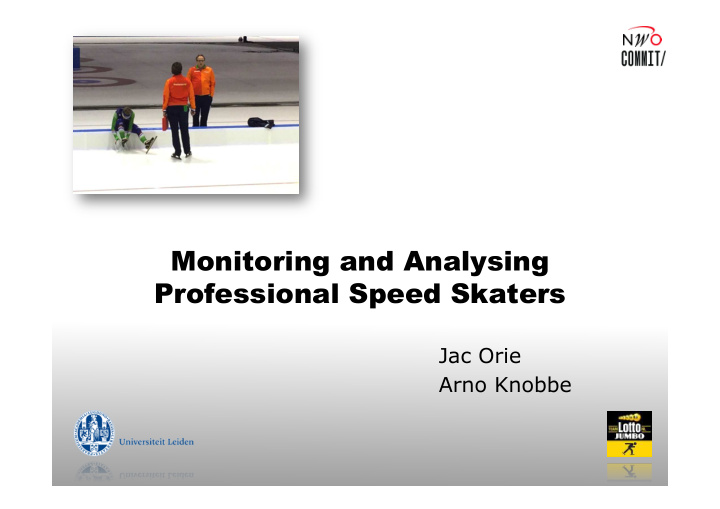



Monitoring and Analysing Professional Speed Skaters Jac Orie Arno Knobbe
LottoNL-Jumbo Speed Skating Team Skaters: Sven Kramer, Wouter Olde Heuvel, Kjeld Nuis, … Some 16 Olympic medals + numerous championships
Why? WE WANT TO WIN Optimal periodization
Periodization ‘ Systematic planning of physical training ’
Challenges in Periodization � Simultaneous development of many abilities decreases effectiveness of training � Adaptation of too many stimuli bad results � Distance/event specific � Athlete-specific � Male vs. female � Individual physique
Block Periodization Models Issurin
Taper Taper = superposition of residual training effects Issurin
Taper/Peak Superposition of residual training effects - timing competition Meso-blocks most complex phase Accumulation Transmutation Realisation residuals 12-30 days 12-25 days 8-14 days Issurin
Historical Training Data 15 years of data collected • Some 40 athletes, currently nine: seven men, two women • Daily training details • • Morning and afternoon training • Six days per week • Training type, intensity (subjective), duration, load Roughly bi-weekly physical test • • Aerobic • Anaerobic Competition data • • Corrected for track-differences
Speed Skating Data
Speed Skating Data 30.0 27.5 25.0 22.5 20.0 17.5 density 15.0 12.5 10.0 7.5 5.0 2.5 0.0 0.98 0.99 1.00 1.01 1.02 1.03 1.04 1.05 1.06 1.07 time_relative
The Effect of Training tapering moment test
Aspects of Periodization Within each window: count How many exercises ? • sum ( duration, load) How many minutes, … ? • max ( duration, intensity, load) Did you recently … ? • stddev ( duration, intensity, load) How varying was … ? • Determiners of specific activities • just in the morning/afternoon • certain intensity ranges (zones) • Sum of duration over 14-day period Max of intensity over 2-day period Sum of duration over 21-day period, morning sessions Sum of duration over 21-day period, intensities 6, …, 9 Maximum of load over 7-day period, cycling … ¡
Modelling Training/Response � Each variable will have a U-shape � Neither too little, nor too much � In theory non-linear, in practice only a sample � linear model � threshold model relative time training load optimum available data
Modelling Training/Response � Each variable will have a U-shape � Neither too little, nor too much � In theory non-linear, in practice only a sample � linear model � threshold model relative time training load optimum
Kjeld Nuis � 178 races � On average 2.89% above track record � Specialises on 1000 m (2.1%) � 2015-2016 � Dutch champion 1000 m, 1500 m � WC Distances: bronze 1000 m, silver 1500 m � WC Sprint: ‘silver’ � ISU World Cup: gold 1000 m, silver 1500 m
1.0550 undesired result 1.0525 due to over-training 1.0500 1.0475 1.0450 1.0425 1.0400 1.0375 1.0350 1.0325 time_relative 1.0300 1.0275 1.0250 1.0225 1.0200 1.0175 1.0150 1.0125 1.0100 1.0075 1.0050 1.0025 1.0000 0.9975 250 500 750 1,000 1,250 1,500 1,750 2,000 sum_load_am_5
Fitness/Fatigue Parameters Kjeld � Parameter fitting on a physiological model of fatigue and supercompensation "fa*gue" "fitness" "kernel" 0" 5" 10" 15" 20" 25" 30" 35" 40"
That’s all! Questions?
Recommend
More recommend